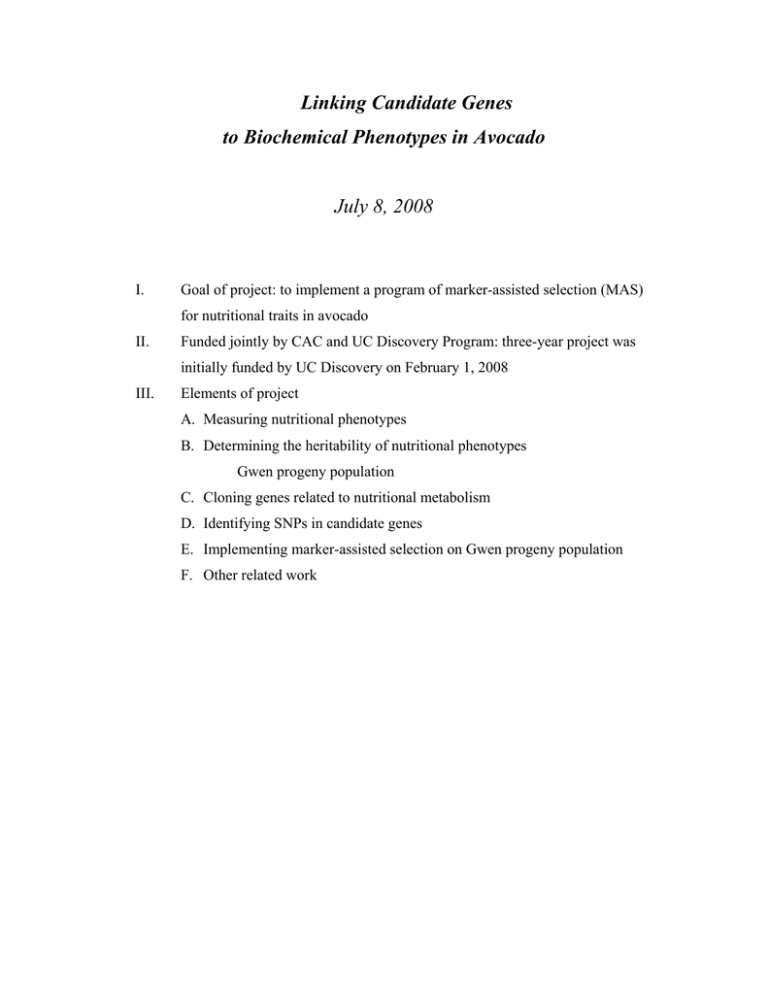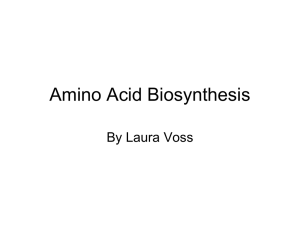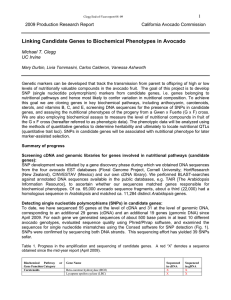Linking Candidate Genes to Biochemical Phenotypes in Avocado July 8, 2008
advertisement

Linking Candidate Genes to Biochemical Phenotypes in Avocado July 8, 2008 I. Goal of project: to implement a program of marker-assisted selection (MAS) for nutritional traits in avocado II. Funded jointly by CAC and UC Discovery Program: three-year project was initially funded by UC Discovery on February 1, 2008 III. Elements of project A. Measuring nutritional phenotypes B. Determining the heritability of nutritional phenotypes Gwen progeny population C. Cloning genes related to nutritional metabolism D. Identifying SNPs in candidate genes E. Implementing marker-assisted selection on Gwen progeny population F. Other related work Rationale and Progress Research suggests that consumption of avocado has a beneficial effect on human health by virtue of an array of antioxidants, vitamins, lutein, and the cholesterol-lowering and anticarcinogenic properties of β-sitosterol. Improvements in nutrition are “value added” traits that can be patented and sold at a premium. The development of new value added cultivars is important for the success of the California avocado industry. • Measure these and related compounds in avocado fruit using thin layer chromatography (TLC) – nutritional phenotype – initial validation of methods in progress • Determine the magnitude of genetic control of variation among trees in these compounds o Quantitative genetic analyses of Gwen progeny population – Methods validated and populations in place • Initial focus on Gwen x Fuerte progeny Clone genes in biosynthetic pathways that determine these compounds o Construct cDNA library - Done o Validate cDNA library – In process o Recover genes of interest (candidate genes) from cDNA library – Will be the focus over the next six months o Identify SNPs in candidate genes – Will commence in year 2. • Employ SNPs for marker assisted selection (MAS) within Gwen progeny population – Will initiate process at end of year 3. • Personnel changes – Vanessa Ashworth has taken a year’s leave to accompany her husband on a sabbatical in Germany. Dr. Livia Tommasini joined the project as a post-doctoral scholar in June 2008 and Dr. Carlos Calderon is expected to join the project as a post-doctoral scholar in late August 2008. Quantitative trait locus (QTL) analysis Detects associations between magnitude of measured trait and a specific genetic marker (SSR allele) 1 QTL1 = SSR marker 2 3 QTL2 Linkage disequilibrium (LD): Segments of DNA inherited as a unit SSR2 still detects QTL1 Table 1. Avocado genes to be sequenced. Sequences available in GenBank (non-chloroplast) as of late 2006 are in boldface Biochemical Pathway or Enzyme or Gene Gene Function Category ABA Biosynthesis Pathways 1. 9-cis-epoxycarotenoid dioxygenase (NCED) 2. Carotenoid cleavage dioxygenase (CCD) Amino Acid Biosynthesis Pathways 3. Arginine decarboxylase 4. Serine/threonine kinase Anthocyanin Biosynthesis & 5. Anthocyanin synthase Phenylpropanoid Pathways 6. Chalcone isomerase 7. Chalcone synthase (CHS) 8. Dihydroflavonol reductase 9. Flavonol 3-hydroxylase (F3H) 10. Flavone synthase 11. Flavonol synthase 12. Phenylalanine Ammonia Lyase (PAL) Carotenoid Pathway 13. ζ-carotene desaturase 14. β-carotene hydroxylase 15. Lycopene β-cyclase 16. Phytoene desaturase 17. Phytoene synthase Cell Wall Hydrolyzing 18. Cellulase Enzymes 19. Endochitinase 20. Polygalacturonase Fatty Acid Synthesis 21. Fatty acid desaturase 22. Fatty acid elongase 23. Lipoxygenase (LOX) 24. Stearoyl-acyl-carrier-protein Fruit Ripening Genes 25. 1-aminocyclopropane-1-carboxylate synthase (ACS) 26. Ethylene response sensor (ERS) 27. Ripening-related protein (pAVOe3) ACC oxidase ethylene forming Isoprenoid & β-sitosterol 28. C-14 reductase Biosynthesis Pathways 29. C-28 methyltransferase enzyme 30. C-8,7 sterol isomerase 31. Delta-7-sterol-C5 desaturase 32. Farnesyl pyrophosphate synthase 33. Geranyl diphosphate synthase 34. Sterol C-24 reductase 35. Sterol delta-7 reductase Sugar Synthesis or Metabolism 36. Beta-D-galactosidase (converts glucose to galactose) 37. Fructose-bisphosphate aldolase Vitamin C 38. GDP-mannose pyrophosphorylase 39. GDP-mannose-3,5-epimerase 40. L-galactono-1,4-lactone dehydrogenase 41. L-galactose dehydrogenase 42. Mannose-6-phosphate isomerase 43. Phosphoglucose isomerase 44. Phosphomannomutase Vitamin E 45. Gamma-tocopherol methyltransferease 46. Homogentisate geranylgeranyl transferase (HGGT) 47. Homogentisic phytyltransferase (HPT) 48. Tocopherol cyclase Miscellaneous Genes 49. Cytochrome P-450 50. Glutathione S-transferase 51. Metallothionein-like protein 52. Mitogen activated protein kinase (MAP kinase) 53. Putative seed imbibition protein Quantitative genetics • Progeny of ‘‘Gwen’ tree grafted onto ‘‘Duke 7’’rootstock in 1999-2000 o 204 genotypes, each has four replicates o Two locations (Irvine,, Riverside) o Randomized block design o Planted in 2001 • Initial quantitative genetic analyses on growth rate and related traits (Chen et al., 2007) Table 2. Growth rate traits Height Broad Sense Heritability 34.31% Canopy Stem Bloom Fruit Diameter Girth Abundance Precocity 29.7% 28.45% 32.3% 23.44% Table 3. Mean effect of different pollen donors Height (cm/mo) Canopy Diameter (cm/mo) Bacon 5.931(A,B 6.045(B) T r u n k Flower Fruit Diameter Abundance Setting (cm/mo) 0.226(A 1.965(A 1.410(B) Fuerte 5.002(C 6.482(A 0.213(A 1.418(C) 1.385(B) Zutano 5.774(B 5.241(C) 0.197(B) 1.846(A 1.614(A Mixed 6.289(A dono 6.484(A 1.446(B) 0.223(A 1.604(B) *A,B and C mean significant difference (p=0.05) Table 4. Correlation among traits Height Height Canopy diameter St em Girth Flower Abundance Fruit Precocity 1 Stem Girth Flowe Fruit Abundance Setting 0.681 0.661 0.096 0.524 1 0.66478 0.08945 0.488 1 0.081 0.411 1 0.179 1






